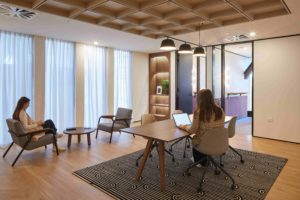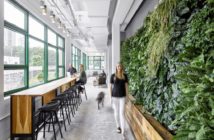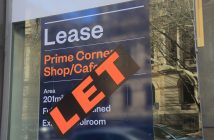As economic conditions continue to tighten across New Zealand, businesses of all sizes are closely examining their cost structures. Inflationary pressures, cautious consumer spending, and ongoing global uncertainty have created an environment where prudent financial management is essential.

For many organisations and especially SMEs, office space is one of the first areas under scrutiny. It’s understandable. Traditional commercial leases typically involve long-term commitments, high upfront fit-out costs, and ongoing operating expenses.
With hybrid working reducing utilisation across many offices, the argument to downsize or cut office space entirely has gained momentum. Is eliminating office space the right solution?
Evidence suggests otherwise. Fully remote models often lead to decreased cohesion, weaker engagement, and challenges in talent attraction and retention. The challenge for businesses is to cut costs without cutting connection, culture, and collaboration. That’s where flexible workspace comes in.
Weight of the traditional lease
Consider a mid-sized business needing six desks and a meeting room, around 96 sqm in Auckland, based on the average allocation of 16 sqm per person. In regional centres, space allocations are even higher due to lower density and a lack of smaller tenancy options, often reaching 50 sqm per person.
The cost structure adds up quickly. Rent and outgoings at $500/sqm total $48,000/year. Add a modest fit-out at $40,000 and another $10,000 for IT and furniture, and you’re $93,000 out of pocket before anyone sets foot in the office.
Leases commonly span six years, include make-good clauses, and come with limited flexibility. Under IFRS 16 accounting standards, lease obligations appear on the balance sheet, reducing borrowing capacity. Meanwhile, fit-out assets depreciate rapidly, even though the liabilities remain.
The flexible alternative
The same six-person team could work from a serviced or co-working space for around $30,000/year, all-inclusive. This covers:
- Fully furnished desks
- Meeting room access
- High-speed internet
- Electricity, cleaning, and rates
- Shared common areas and kitchen facilities
There’s no CapEx, no OPEX, no make-good, and no long-term liability. Year One savings easily exceed $40,000. On the balance sheet, there’s no lease liability or depreciating asset. And since the space is plug-and-play, businesses can scale up or down as needed.
Summary Comparison for a standard B grade asset
| Location | Traditional Office (Annual) | Coworking (Annual) | Savings |
| Auckland | $113,200 | $61,200 | $52,000 |
| Wellington | $119,400 | $54,000 | $65,400 |
| Christchurch | $119,400 | $54,000 | $65,400 |
| Regional Cities | $123,000 | $46,800 | $76,200 |
Although the regions offer lower rental, it often comes with a higher price tag due to the higher allocation of space, especially for quality premises.
The Sunk Cost of Fit-Out
Traditional leases typically require tenants to fund their own fit-outs or at least a portion of it. For a 96 sqm space at $850/sqm, this amounts to $81,600. It becomes a sunk cost, unrecoverable at lease end and subject to depreciation (~$16,320/year). Tenants may also need to return the space to base-build condition, compounding losses.
Coworking, by contrast, requires no upfront fit-out investment. Offices are already fully furnished and maintained.
Equity Impact – Five year lease vs coworking (Auckland)
| Traditional Lease | Coworking | |
| Fit-Out CapEx (Year 1) | -$81,600 | $0 |
| Lease Liability (IFRS 16) | ~$240,000 | $0 |
| Asset Value (fit-out) | +$81,600 → $0 after 5 years | $0 |
| Year 1 Cash Burn | ~$129,600 (CapEx + rent + OPEX) | $61,200 |
| Net Equity Impact | -$240k lease liability, +sinking asset | No liability or asset |
| Balance Sheet Flexibility | Restricted | Fully flexible |
Flexibility That Pays Off over the long term
We modelled two business scenarios over five years:
Scenario 1: Growth from 3 to 10 Staff
| Year | Staff | Coworking | Traditional Lease |
| 1 | 3 | $30,600 | $131,200 |
| 2 | 4 | $40,800 | $75,200 |
| 3 | 6 | $61,200 | $75,200 |
| 4 | 8 | $81,600 | $75,200 |
| 5 | 10 | $102,000 | $75,200 |
| Total | — | $316,200 | $432,000 |
Scenario 2: Shrinking from 30 to 15 Staff
| Year | Staff | Coworking | Traditional Lease |
| 1 | 30 | $306,000 | $262,400 (incl. $163k fit-out) |
| 2 | 27 | $275,400 | $126,400 |
| 3 | 24 | $244,800 | $126,400 |
| 4 | 21 | $214,200 | $126,400 |
| 5 | 18 | $183,600 | $126,400 |
| Total | — | $1,224,000 | $767,200 |
Cutting Space Without Cutting Culture
Reducing costs by going fully remote may seem like an obvious win — but it comes at a cost. Remote-only teams often experience:
- Lower engagement
- Weaker onboarding and collaboration
- Diluted company culture
- Higher staff turnover
Flexible workspaces offer a third path: a place to collaborate and stay connected—without the rigidity or risk of long-term leases.

Soft benefits that add hard value
Beyond the financial upside, flexible workspaces deliver real operational advantages:
- Premium Environments – Ergonomic furniture, natural light, soundproofing, and modern design.
- Hospitality Touchpoints – Onsite cafés, concierge service, and hotel-like amenities.
- Wellness Facilities – End-of-trip showers, quiet rooms, bike storage, and greenery.
- Networking Opportunities – Proximity to other professionals encourages serendipitous connections.
- Professional Development – Onsite events, workshops, and learning opportunities.
For small teams, regional outposts, or project-based operations, these benefits can be transformative.
Unique opportunity for property owners
This economic climate also presents a powerful opportunity for landlords. B-grade office stock is increasingly under-utilised. With strategic CapEx investment, these buildings can be repositioned into high-performing flexible workspace hubs.
This model benefits everyone:
- Occupiers gain access to high-quality, managed environments.
- Owners benefit from greater space efficiency (12 desks per 100 sqm in coworking vs one person per 16 sqm traditionally).
- Fitouts are preserved and upgraded over time rather than gutted and rebuilt each lease cycle, reducing CapEx waste and downtime.
It’s a win-win for users and investors alike, with flexible workspace delivering higher yield than traditionally leased buildings.
The new normal
Flexibility, Agility and Value
New Zealand businesses face real pressure but the solution isn’t to cut deeper, it’s to cut smarter with a focus on productivity. Office space remains critical to culture, connection, and performance.
The real question is not whether to have space, but what kind.
Flexible workspaces reduce financial pressure, support agile operations, and give people a reason to come together.
In a volatile world, that’s more than a nice-to-have. It’s a strategic edge.
Because the real savings come not just from cutting costs, but from building resilience and agility.



